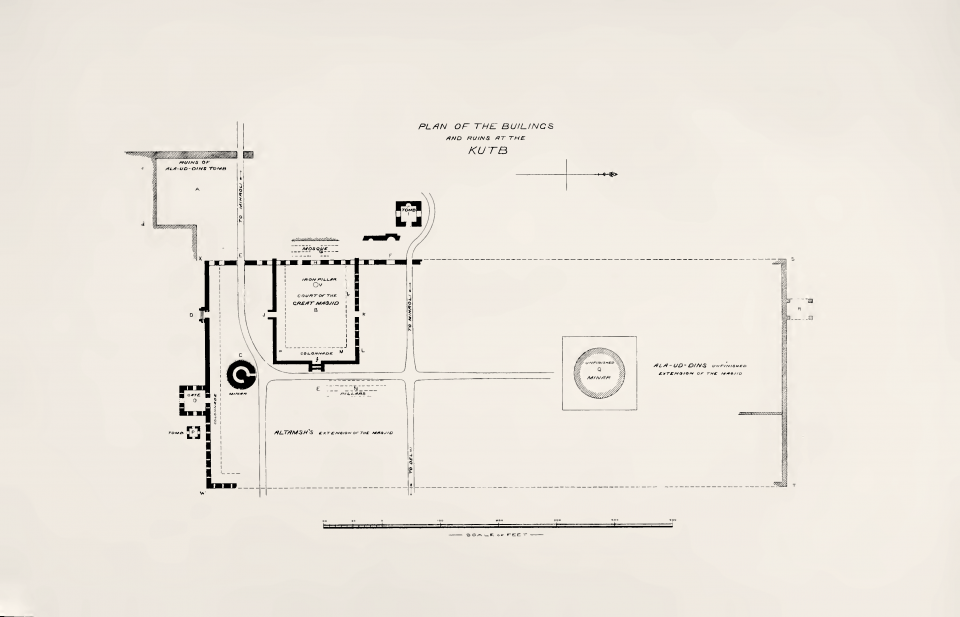THE tomb of the Sultan Sharns-ud-din Altamsh is situated to the north-west of the Kutb ruins, and passed to the north by the road which leads from the Kutb Dak Bangalow to the village of Mihroli, about a quarter of a mile off. The building is square, with sides measuring forty-three feet and a hah", the walls are seven feet thick and the interior measures twenty-nine and a half feet square. It was erected by his two children, Sultan Rukn-ud-din Firuz Shah and the Sultana Riziah about A.D. 1236. The former reigned for about six months, but during this time no public events of any great importance occurred and he liTed a low and debauched life. His sister the Sultana succeeded him in the possession of the capital as the first Empress of India. Her reign would have prospered had she not fallen in love with an Abyssinian who was in employment about her court, and thus given rise to resentment among her nobles. A rebellion arose and in A.D. 1239 she was defeated by the governor of Sirhind; the Abyssinian met with his death, and she was captured and shut up in the Zenana of the conqueror. The governor in advancing on Delhi was overcome, and he and the Sultana met their death. The latter was buried in Delhi, where her tomb still exists, though in ruins.
The exterior of Shams-ud-din's tomb is of grey quartz, the walls being plain, with the exception of the doors, which are carved and decorated with arabesques and inscriptions in Kufic and Arabic, containing verses from the Koran. I have been fortunate enough to procure the numbers of the verses, through the kindness of Dr. Rieu of the British Museum. In the examination of the photograph, he made out that the inscription round the outer doorway consists of verses 21—24 from LIX. Koran; the writing round the pointed arch embodies verses 1—10 from LV. Koran, and that round the interior of the doorway, perceptible beyond, consists of verses 14—16, XXIII. Koran.
The photograph is taken from the south; there are doorways on all sides excepting to the west; but there appears to be some doubt as to the existence at any time of a covering or dome to the roof; however, the Sultana lived long enough in Delhi to have attended to its completion, and I cannot help thinking that had no roof ever existed the interior would have suffered more than at present appears, from the state of the carvings which are of sandstone.
This building is perhaps the earliest Muhammadan tomb in India, and the most perfect existing shrine among several other Pathan tombs of a later date. In this respect, therefore, it is a valuable record of one class of early Pathan buddings, and is as worthy of being carefully preserved as a unique example of Indian architecture as is the great Kutb Minar—the upper portions of which are contemporaneous with it.
One of the most striking features of the Pathan methods of ornamentation is illustrated in this Photograph, and consists in the even-balancing of the plain and decorated surfaces, and in the light and shade produced by the raised patterns. This quality of evenly-distributing ornament over a flat surface, has in all times been inherently natural to Muhammadan designers of architectural buildings, and originated, no doubt, with their love for geometric patterns, which they invent to the present day with greater ease and with even a greater degree of variety and ingenuity than any other people in the world. The study of patterns, the construction of which is based upon a strict adherence to mathematical law, whereby a perfection of distribution and balance of parts are secured, induced naturally a facility in the composition of ornaments the detads of which are not strictly confined to geometrical figures; and this facility became developed in the handling and treatment of every description of outline.
A good series of examples of Muhammadan ornament, in which this quality is very marked, are to be found in the carved panels of the Sultana's apartments in Akbar's palace at Fathpiir Sikri, and casts of them may be seen in the Kensington Museum.
![Exterior of Shams-ud-Din's Tomb [Iltutmish's Tomb, Qutb] Exterior of Shams-ud-Din's Tomb [Iltutmish's Tomb, Qutb]](https://architexturez.net/data/styles/large/public/media/architectureofan00cole-page-151.png?itok=x7ysTsjD)
